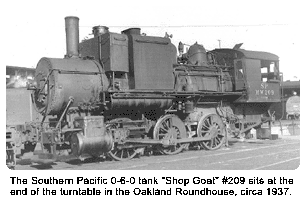The Southern Pacific Railroad was founded in 1865 by a group of businessmen led by Timothy Phelps.
Although the railroad got off to a good start, a team of magnates, so-called the Big Four¹, were eyeing the growing company. In 1868, they purchased the Southern Pacific.
Spanning the country
Following the purchase, the Southern Pacific merged the Central Pacific Railroad into its system in 1870. The merge included several smaller locomotive companies owned by Central Pacific, which created an excellent base for the Southern Pacific. Those companies spanned the United States, allowing the newly merged companies to more easily access resources when needed.
The newly merged company was then able to machine-tool their own parts, and built their first locomotive in June 1873. Built in Sacramento, California, the engine became the company's pride and joy. That new creation served to fuel the owners' ideas.
Between 1874 and 1881, the Southern Pacific used its resources from all over the United States to build new tracks that would span the country. The feat was accomplished on January 12, 1883, when the second transcontinental railroad line was completed.²
On April 1, 1885, the Southern Pacific railroad decided to take control of their partner, the Central Pacific. Following the acquisition, it was determined that the Central Pacific would no longer remain a separate company, and the two companies integrated everything under the Southern Pacific name.
Refrigeration
The first refrigerated rail cars were introduced in 1886. The cars were a big hit because perishable products could be shipped farther. With that ability, the Southern Pacific and Union Pacific opened the Pacific Fruit Express (PFE) in 1906. That new rail line was dedicated to transporting goods that needed refrigeration.
In 1913, the U.S. Supreme Court ruled that the Union Pacific had to sell all of its stock to the Southern Pacific. That decision concluded the tandem operations of both companies as well as the Southern Pacific's interest in purchasing the Union Pacific.
War intervenes
On December 28, 1917, the federal government
took control of all rail operations in the United States in the interest of national security, as it prepared for World War I.
Following the war, the federal government slowly allowed control to revert to private hands, beginning with the Southern Pacific. Being the first company, the Southern Pacific managed to acquire control of more than 87 percent of the Cotton Belt Railroad.
 Diesel replaces steam
Over the next few years, Southern Pacific introduced numerous new railroad products, which injected new excitement into the industry. In 1947, the company introduced the first diesel locomotives and began feeding them into the company's main operations. Following the diesel engine, the Trailer-on-Flat-Car (TOFC or "piggyback") was brought into service in 1953. That innovative rail car made the transportation of large cargo much easier and created more versatile ways to move industrial equipment.
As the diesel engines were brought "up to speed," the steam locomotives were gradually removed from the Southern Pacific service line. The last steam locomotive was retired from service in 1957. Those locomotives were the workhorses of rail history up to that point; they were the pioneers, completing the historic first trips across the United States.
Southern Pacific is acquired
In 1984, the Santa Fe Railroad merged with Southern Pacific (along with many smaller rail lines) to form the Santa Fe Southern Pacific Corporation. However, the Interstate Commerce Commission (ICC) took exception to the merger conditions. Instead, the company was ordered to make some changes, one of which resulted in the
shortened name of Santa Fe Pacific Corporation.
Following some discussion around the details of the merger, it was decided that the Southern Pacific name would be put up for sale. Four years later, on October 13, 1988, the Southern Pacific Railroad was acquired by Rio Grande Industries. After taking control of the Southern Pacific and a long debate of what to do with it, it was decided that they would maintain the name Southern Pacific for the railroad operations.
Even though Rio Grande Industries held good intentions for the Southern Pacific, it was taken over by the Union Pacific Railroad because of Rio Grande's financial difficulties.
Diesel replaces steam
Over the next few years, Southern Pacific introduced numerous new railroad products, which injected new excitement into the industry. In 1947, the company introduced the first diesel locomotives and began feeding them into the company's main operations. Following the diesel engine, the Trailer-on-Flat-Car (TOFC or "piggyback") was brought into service in 1953. That innovative rail car made the transportation of large cargo much easier and created more versatile ways to move industrial equipment.
As the diesel engines were brought "up to speed," the steam locomotives were gradually removed from the Southern Pacific service line. The last steam locomotive was retired from service in 1957. Those locomotives were the workhorses of rail history up to that point; they were the pioneers, completing the historic first trips across the United States.
Southern Pacific is acquired
In 1984, the Santa Fe Railroad merged with Southern Pacific (along with many smaller rail lines) to form the Santa Fe Southern Pacific Corporation. However, the Interstate Commerce Commission (ICC) took exception to the merger conditions. Instead, the company was ordered to make some changes, one of which resulted in the
shortened name of Santa Fe Pacific Corporation.
Following some discussion around the details of the merger, it was decided that the Southern Pacific name would be put up for sale. Four years later, on October 13, 1988, the Southern Pacific Railroad was acquired by Rio Grande Industries. After taking control of the Southern Pacific and a long debate of what to do with it, it was decided that they would maintain the name Southern Pacific for the railroad operations.
Even though Rio Grande Industries held good intentions for the Southern Pacific, it was taken over by the Union Pacific Railroad because of Rio Grande's financial difficulties.